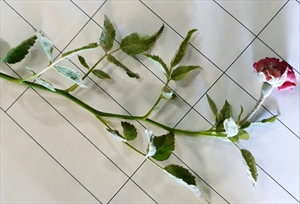Rose powdery mildew
Pacific Pests, Pathogens, Weeds & Pesticides - Online edition
Pacific Pests, Pathogens, Weeds & Pesticides
Rose powdery mildew (387)
Podosphaera pannosa; previously it was known as Sphaerotheca pannosa.
Asia, Africa, North, South and Central America, the Caribbean, Europe, Oceania. It is recorded from Australia, New Caledonia, New Zealand, and Tonga.
Rose
Powdery mildews obtain nutrients from living hosts: they are 'obligate parasites'. Infections caused distortions to leaves, stems and flowers. A white to pale-grey powder-like growth occurs over young leaves, stems and buds. The powdery appearance is due to long chains of spores ('conidia') that stand erect from strands of the fungus (the 'mycelium') that covers the plant surface. The conidia are asexual spores, formed without mating.
As the fungus grows over the plant, slender projections penetrate the plant to absorb nutrients.
Warm, dry days followed by cool, humid nights encourage outbreaks of the disease. Spread occurs by spores carried in wind. Unlike other fungi, they can germinate on dry surfaces, they do not need a film of water on the leaf; in fact, water on the plant surface may prevent germination.
In temperate climates, the fungus overwinters as sexually formed 'cleistothecia', which discharge their spores in the spring. These are not seen commonly in the tropics. Here, the powdery mildew spreads by conidia throughout the year. However, wherever it grows it can survive in buds, emerging with the appearance of the flowers.
Infections by powdery mildew distort leaves and stunt bud growth, producing disfigured flowers. A powdery mildew-infected flower has much lower economic value than a healthy one.
Look for the white powdery growth on leaves, stems and buds.
CULTURAL CONTROL
There are a number of measures that can be taken to limit the impact of the disease:
Before planting:
- Check plants in the nursery to ensure they are free from powdery mildew infection.
- Space roses so that air circulates freely between them to reduce humidity.
- Plant in full sun (ultraviolet light kills fungal spores), maintain good soil drainage and water regularly (see below).
During growth:
- Avoid overhead and evening watering, which cause high humidity. Instead, water in the morning so the soil surface can dry out.
- Avoid over-fertilizing, especially with high nitrogen fertilizers that produces an abundance of weak new growth and fewer blooms. Young growth is especially susceptible to the disease.
- Avoid touching healthy leaves with hands or pruning shears (secateurs) so as not to spread the disease, and sterilise secateurs by wiping with bleach after pruning.
- Weed around plants to keep humidity as low as possible.
- Always remove heavily infected plant parts before treating with fungicides.
RESISTANT VARIETIES
There are many rose species and hundreds of varieties, so obtain advice from nurseries, garden centres, or from growers' catalogues about tolerance or resistance to powdery mildew before making a purchase.
CHEMICAL CONTROL
Home-made treatments:
- Baking soda (sodium bicarbonate): Use 3 teaspoons (15 ml) of ordinary baking soda for each 4.5 L (1 gallon) of water plus half a teaspoon of liquid soap. Spray on the tops and undersides of leaves. It will not eradicate infections, but will prevent them from spreading to healthy leaves and allow plants to recover.
- Use full strength milk: dilute 1 part in 10 parts water. Repeat if there are heavy infections. Spray during cooler parts of the day.
- Use a vinegar-water mixture: 4 tablespoons (15 mls) vinegar in 4.5L water (1 gallon).
Biorational treatments:
- Use neem oil or any one of a number of plant oils, e.g., garlic, corn, rosemary, thyme and clove oils.
- Use horticultural oil.
- Use sulphur (lime or wettable) or copper compounds, e.g., copper sulphate, cupric hydroxide or cuprous oxide.
- Potassium bicarbonate: this is similar to sodium bicarbonate.
- Note, these may be acceptable to organic regimes, but check certification regulations before using them.
Synthetic (commercial) fungicides:
- There are many types of fungicides active against powdery mildews; some that are approved for use on roses in Australia are as follows: (i) protectant fungicides - mancozeb, mancozeb/sulphur, mancozeb/captan); (ii) systemic, curative or eradicant fungicides - bitertanol (triazole fungicide), difenoconazole (triazole fungicide), trifloxystrobin/tebuconazole (combined strobilurin and triazole fungicide). Spray protectant fungicides every 2 weeks, systemic fungicides less often.
- Note for systemic fungicides, carefully follow the manufacturers' directions, including the number of consecutive applications before changing to a fungicide belonging to a different class to avoid selection of resistant powdery mildew strains.
- Choose a dry, calm day to apply the products and reapply after rain or every seven to 10 days for most effectiveness.
____________________
When using a pesticide, always wear protective clothing and follow the instructions on the product label, such as dosage, timing of application, and pre-harvest interval. Recommendations will vary with the crop and system of cultivation. Expert advice on the most appropriate pesticide to use should always be sought from local agricultural authorities.
AUTHOR Grahame Jackson & Mani Mua
Information from Podosphaera pannosa. Wikipedia. (https://en.wikipedia.org/wiki/Podosphaera_pannosa); and Podosphaera pannosa (powdery mildew of rose) (2018) Crop Protection Compendium (www.cabi.org/cpc); and from Pegg K & Manners A (2015) Powdery mildew: A myriad of nursery pathogens. Agri-science Queensland, Department of Agriculture, Fisheries, Ecosciences Precinct, Brisbane QLD. https://www.horticulture.com.au/growers/help-your-business-grow/research-reports-publications-fact-sheets-and-more/powdery-mildew---a-myriad-of-nursery-pathogens/). Photo 1 Clemson University - USDA Cooperative Extension Slide Series, Bugwood.org.
Produced with support from the Australian Centre for International Agricultural Research under project HORT/2016/18: Responding to emerging pest and disease threats to horticulture in the Pacific islands, implemented by the University of Queensland and the Pacific Community.





